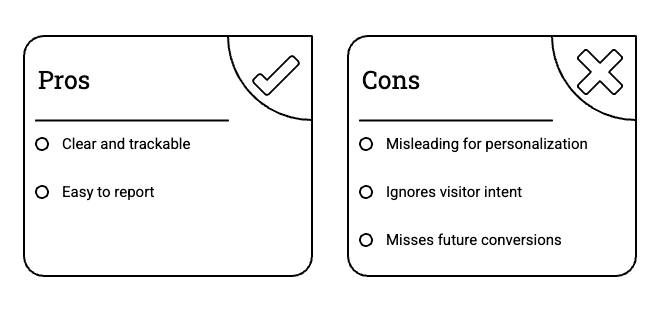Conversion rate has killed more good ideas than bad ones. In this post, we’ll show you how to choose personalization metrics that actually reflect visitor intent.
It’s the north star metric for many eCommerce teams because it’s clear, trackable, and easy to report. However, when you’re running a personalization or experimentation program, it can also be completely misleading.
Why? Because not every visitor is on your site to convert, at least not yet.
Some visitors are exploring. Others are comparing. Many are returning to finish what they started. If you judge every experience by whether it immediately converts, you’ll kill the things that actually help visitors move forward.
And you’ll miss what’s working for the people who will convert—just not right now.
Conversion Rate: The Pros and the Problems
Mistake #1: One KPI to Rule Them All
Personalization isn’t about getting everyone to do the same thing. So why do we measure it like it is?
We’ve seen plenty of campaigns that lowered bounce rate and increased time-on-site but didn’t lift conversion yet. Instead of seeing that as progress, teams call it a failure. As a result, good ideas get buried.
That’s how good ideas get buried. When you measure everything by conversion, you erase the nuance of visitor intent.
Smarter Personalization Metrics by Intent
Visitors don’t all arrive with the same goal. That’s why your metrics shouldn’t either.
| Intent Level | What They’re Likely Doing | Smarter Metrics to Track |
|---|---|---|
| Low Intent | Browsing, exploring, early journey | Bounce rate, session depth, return visits |
| Medium Intent | Comparing products, engaging with content | PDP depth, add-to-cart rate, feature usage |
| High Intent | Returning, ready to purchase | Checkout rate, AOV, revenue per visitor |
Each level of intent has its own version of success. If you measure it wrong, you’ll make bad decisions.
A 70% bounce rate for low-intent visitors might be totally normal. That page may have done its job: filter out the noise.
As you mature, layer in segment-specific metrics. Deal-seekers may respond to promo click rates. Luxury shoppers? They’re watching engagement with high-AOV collections.
Case Study: How Ignoring Conversion Rate Would Have Killed a 40% Win
We launched an engagement ring style quiz designed to help shoppers identify their preferred ring style. The quiz saw strong engagement rates, with many visitors completing it but it didn’t immediately lift conversion rates.
That’s where most teams would stop. But we used the quiz results to personalize future visits.
When those visitors returned, we:
- Updated the homepage hero to reflect their selected style, with a CTA to shop that collection
- Personalized product recommendations to show popular rings in that specific style
The result? Interaction with the personalized content significantly outperformed the default experience. Conversion rates across all styles increased by 11% and for some style collections, conversions rose by over 40%.
If we had only looked at the initial quiz experience and measured by conversion, we would’ve missed the actual win. Measuring across the journey—and by segment—told the real story.
Red Flags Your Personalization Metrics Are Misleading You
Here are a few red flags that suggest your KPIs are working against you:
- Killing experiments with high engagement but flat conversion
- Ignoring metrics like scroll depth, return visits, or interaction rates
- Treating bounce rate as universally bad (it’s not)
- Optimizing only for short-term revenue, not lifetime value
How to Fix It
- Segment your KPIs by intent. Even if the experience is the same, look at how different groups respond.
- Redefine success per experience. A homepage rec block should not be measured like a checkout test.
- Run holdouts. Measure how a segment performs without the personalized experience, not just how it compares to average.
- Look beyond single-session metrics. Especially for low-intent visitors, it might take multiple visits to convert.
How to explain this to your team: “This experience wasn’t designed to convert today. It was designed to move people closer to purchase. And it did.”
Final Thought
If you judge every visitor by whether they convert right now, you’ll miss the real story.
Smart personalization isn’t about forcing the outcome it’s about meeting people where they are, helping them move forward, and knowing what success actually looks like for them.
Get the metrics right, and the insights will follow.
Next Read:
- Forget Who They Are. Personalize for What They’re Trying to Do.
- Download the Intent Wins Playbook
- Work with Craig to Audit Your Personalization KPIs
